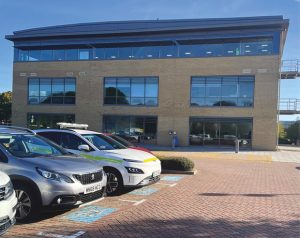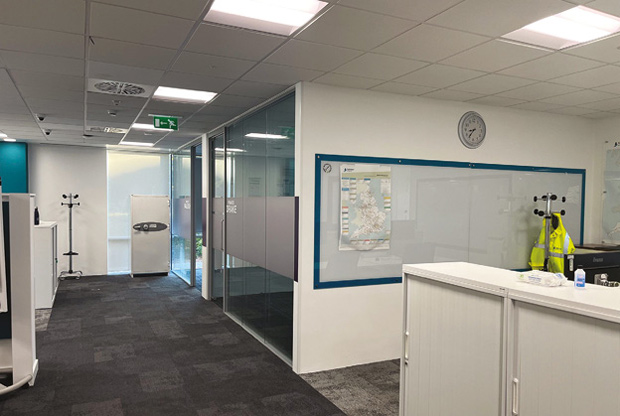FROM DATA TO ACTION
A critical feature of E60+ is its ability to tailor recommendations to the unique operational context of each building. In Brunel House, the tool monitored real-time carbon intensity data from the UK grid, cross-referencing it with occupant patterns, appliance demand, and HVAC (heating, ventilation, air conditioning) system performance. The AI then calculated which systems could safely reduce load during high-carbon periods, such as late afternoons and early evenings, and which were critical to maintain at all times.
One of the first actionable insights was strikingly straightforward: by reducing the office’s HVAC output by less than a degree Celsius from 4pm to 6pm (when grid carbon intensity typically peaked), the building could achieve daily savings of 24kg of CO₂e, without sacrificing comfort or operational effectiveness. This minor adjustment, when consistently applied, resulted in a nine per cent overall energy reduction and generated an estimated annual financial saving of £14,235. Over the course of a year, this equated to an impressive carbon reduction of around 5,520kg CO₂e.
QUANTIFYING THE IMPACT
The quantitative outcomes of the trial at Brunel House make a compelling case for the broader application of AI-powered energy management tools:
- Daily CO₂e Savings: 24kg
- Annual CO₂e Reduction: Approximately 5,520kg
- Energy Reduction: 9 per cent in the trial building
- Annual Financial Saving: £14,235
These results were achieved with no impact on operational KPIs or occupant comfort, challenging the common perception that energy savings must come at the cost of user experience. Indeed, the trial not only demonstrated what was possible through minor operational changes but also inspired the National Highways team to consider further optimisations and to drive broader behavioural change across their estate.
LESSONS FOR THE PUBLIC SECTOR AND BEYOND
This trial at Brunel House highlights that even small operational adjustments can deliver significant savings without compromising comfort or key performance indicators. It also offers several important lessons for public sector organisations seeking to optimise their energy use and reduce their carbon footprints:
- Data as an enabler: The use of real-time data and AI-driven analytics can help identify opportunities for energy savings that might otherwise be overlooked, especially in complex, multi-use buildings.
- Incremental changes, significant impact: Even small, well-timed interventions – such as minor adjustments to HVAC settings – can deliver substantial cost and carbon savings.
- Behavioural change: Successes like this can help build momentum for wider adoption of energy efficiency measures, fostering a culture of innovation and sustainability.
- Cost-effective action: The initiative demonstrates that significant improvements are possible without large capital outlays, making them accessible even in times of fiscal constraint.
- Communication: Staff engagement and feedback is vital to its successful rollout. Clear communication enables teams to manage expectations, gauge impact and modify interventions to ensure the building and its assets continue to respond to the demands of its occupiers.
TOWARDS SCALABLE, SUSTAINABLE SOLUTIONS
The Brunel House project stands as a testament to what can be achieved when technology, data, and operational expertise are brought together with a clear focus on sustainability and value for money. As public sector organisations seek to navigate an increasingly complex landscape, the lessons of this initiative, both in terms of what was achieved and what remains to be explored – offer a valuable roadmap.
Yet, as with any pioneering initiative, there are gaps that warrant further investigation to ensure the approach is truly scalable and sustainable. Gathering more comprehensive data on occupant experience, long-term savings, and integration challenges will be essential for informing future efforts across the entire public sector estate.
By continuing to foster a spirit of collaboration and innovation, and by rigorously evaluating both successes and setbacks, organisations like Amey and National Highways can lead the way towards a greener, more efficient future – one data-powered, AI-optimised building at a time.
 Concludes David Aird, Amey Business Director, Net Zero & Energy Solutions: “As we continue to drive innovation in energy efficiency and decarbonisation across the public sector, the Brunel House project has clearly demonstrated the impact of combining advanced AI solutions with a spirit of genuine collaboration.
Concludes David Aird, Amey Business Director, Net Zero & Energy Solutions: “As we continue to drive innovation in energy efficiency and decarbonisation across the public sector, the Brunel House project has clearly demonstrated the impact of combining advanced AI solutions with a spirit of genuine collaboration.
“Our partnership with National Highways has shown that when client and service provider work closely together, we’re able to unlock the full potential of smart technology – delivering measurable carbon savings, cost reductions, and operational resilience. These achievements aren’t just the result of technology alone; they’re built on trust, communication, and a shared commitment to sustainability.”





